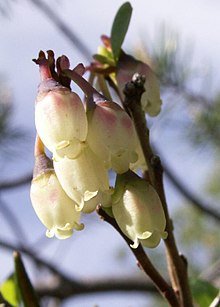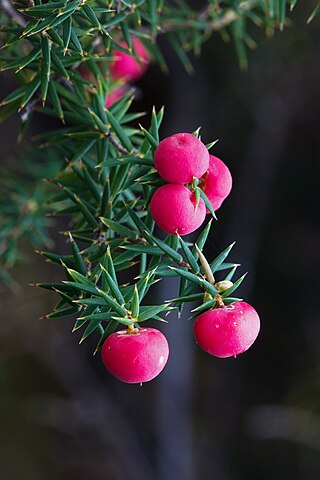
The Ericaceae are a family of flowering plants, commonly known as the heath or heather family, found most commonly in acidic and infertile growing conditions. The family is large, with about 4,250 known species spread across 124 genera, making it the 14th most species-rich family of flowering plants. The many well known and economically important members of the Ericaceae include the cranberry, blueberry, huckleberry, rhododendron, and various common heaths and heathers.

Erica is a genus of roughly 857 species of flowering plants in the family Ericaceae. The English common names heath and heather are shared by some closely related genera of similar appearance. The genus Calluna was formerly included in Erica – it differs in having even smaller scale-leaves, and the flower corolla consisting of separate petals. Erica is sometimes referred to as "winter heather" to distinguish it from Calluna "summer heather".

Empetrum is a genus of three species of dwarf evergreen shrubs in the heath family, Ericaceae. They are commonly known as crowberries and bear edible fruit. Species of Empetrum include: E. nigrum (crowberry) and its tetraploid subspecies E. nigrum ssp. hermaphroditum, E. eamesii and E. rubrum.

Agarista populifolia is a plant species in the family Ericaceae with the common name of Florida hobblebush. It forms dense thickets which are difficult to penetrate, thus the common name. Stems often arching. It is found in the southeastern United States inhabiting moist to wet woodlands. It is an evergreen shrub with small white flowers on the underside of its arching branches.

The Nacophorini are one of the smaller tribes of geometer moths in the subfamily Ennominae. They are the most diverse Ennominae of Australia and are widespread in the Americas. If the African genera tentatively placed herein indeed belong here, the distribution of the Nacophorini is distinctly Gondwanan, with their probable origin either of Australia, South America or even Antarctica. In Eurasia, they are rare by comparison.
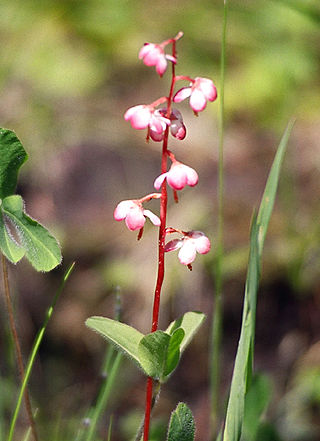
Pyroloideae is a subfamily of plants in the family Ericaceae. It was formerly treated as a separate family, Pyrolaceae. It has also been treated as the tribe Pyroleae within the subfamily Monotropoideae. It consists of four genera: Chimaphila containing 5 species, Pyrola containing 30 species and Moneses and Orthilia which are monotypic. They are mixotrophic, gaining nutrition from photosynthesis, but also from mycorrhizal fungi.

Dracophyllum longifolium, commonly called inaka, is an upright shrub or small tree in the family Ericaceae that is endemic to New Zealand.
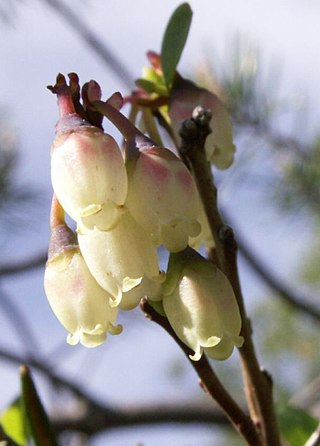
Vaccinieae is a tribe of over 1000 species in the plant family Ericaceae. The tribe consists of morphologically diverse woody plants. Species within Vaccinieae can be found on all continents except Australia and Antarctica. Genetic analysis indicates that Vaccinieae is not a monophyletic group.

Ericoideae is a subfamily of Ericaceae, containing nineteen genera, and 1,790 species, the largest of which is Rhododendron, followed by Erica. The Ericoideae bear spiral leaves with flat laminae. The pedicel is articulated and the flowers are pendulous or erect, and monosymmetric, with an abaxial median sepal. The carpels are free and the anthers lack appendages. The capsule is septicidal.
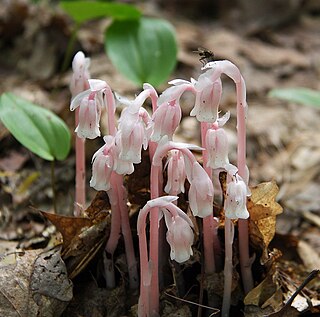
Monotropoideae, sometimes referred to as monotropes, are a flowering plant subfamily in the family Ericaceae. Members of this subfamily are notable for their mycoheterotrophic and non-photosynthesizing or achlorophyllous characteristics.

The Arbutoideae are a subfamily in the plant family Ericaceae. Phylogenetic analysis supported all genera of the subfamily as monophyletic, except Arbutus. Moreover, it was suggested that the non-sister relationship between Mediterranean and North American species may be explained by a once widespread distribution in the Northern hemisphere before the Neogene.

Bryanthus is a monotypic genus of ornamental plant in the flowering plant family Ericaceae, with the sole species Bryanthus musciformis, native to Japan, Kamchatka, and the Kuril Islands. The genus was created in 1769. In 2012, the new tribe Bryantheae was proposed based on genetic analysis, containing the genera Bryanthus and Ledothamnus.
Periclesia is a monotypic genus of flowering plants belonging to the family Ericaceae. It only contains one known species, Periclesia flexuosaA.C.Sm. It is also with the Vaccinioideae subfamily and the Vaccinieae tribe.

Ledothamnus is a genus of flowering plants belonging to the family Ericaceae. Its native range is Northern South America to Northern Brazil.

Dracophyllum muscoides, commonly known as cushion inaka, is a small cushion plant in the family Ericaceae. It is endemic to New Zealand and is found only in the South Island in sub-alpine regions.

Dracophyllum verticillatum is a species of shrub or small tree endemic to New Caledonia. It was first described by Jacques Labillardière in 1800 and gets the specific epithet verticillatum for its flowers growing on verticillasters. In the heath family Ericaceae, it inhabits exposed plains and gentle mountain slopes and reaches a height of 0.2–7 m tall.

Dracophyllum menziesii, commonly known as pineapple scrub, is a species of shrub endemic to the South and Stewart Islands of New Zealand. In the heath family Ericaceae, it inhabits mountain slopes and cliffs from sea level up to 1,500 m (4,921 ft) and reaches a height of 0.5–1 m (1.6–3.3 ft). A 2017 assessment using the New Zealand Threat Classification System classified it as "Not Threatened", giving it an estimated population upwards of 100,000.

Dracophyllum densum is a species of shrub endemic to north-west Nelson in New Zealand's South Island. It was first described by Walter Oliver in 1952 and gets the specific epithet densum for its leaves growing densely. In the heath family Ericaceae, it inhabits mountain summits, plateaux, and ridge lines and reaches a height of 0.3–0.5 m (1–2 ft). A 2017 assessment using the New Zealand Threat Classification System classified it as "Declining", giving it an estimated population of more than 100,000.

Epacridoideae is a subfamily of the family Ericaceae. The name StyphelioideaeSweet is also used. The subfamily contains around 35 genera and 545 species. Many species are found in Australasia, others occurring northwards through the Pacific to Southeast Asia, with a small number in South America.
